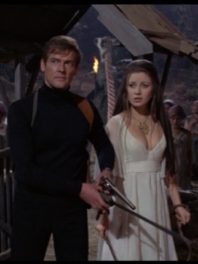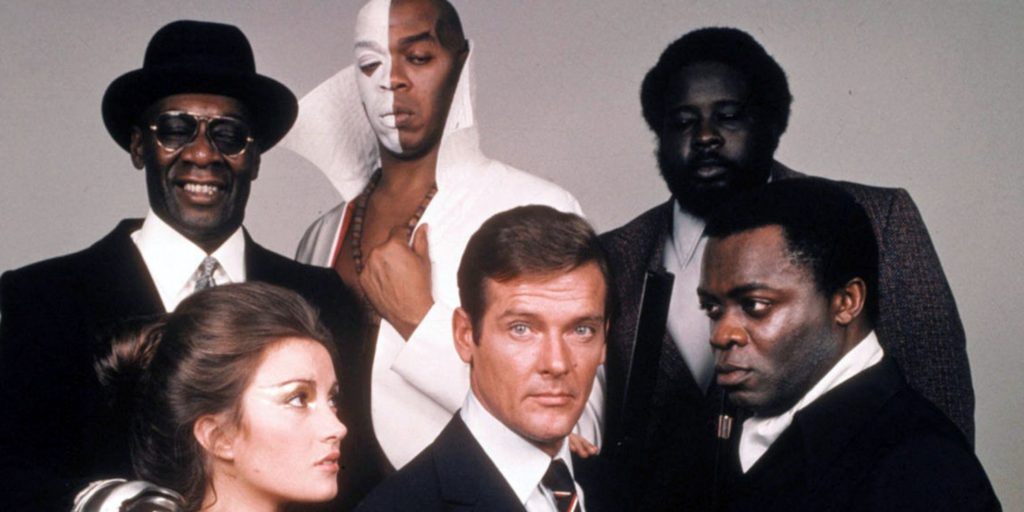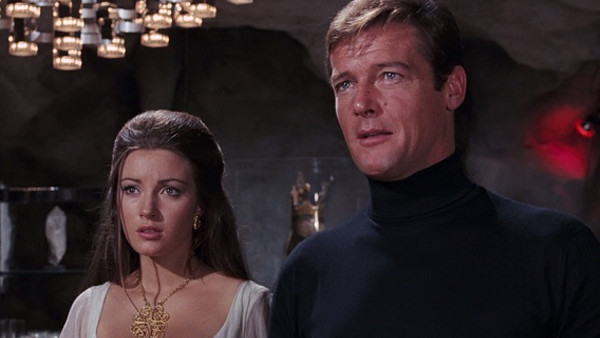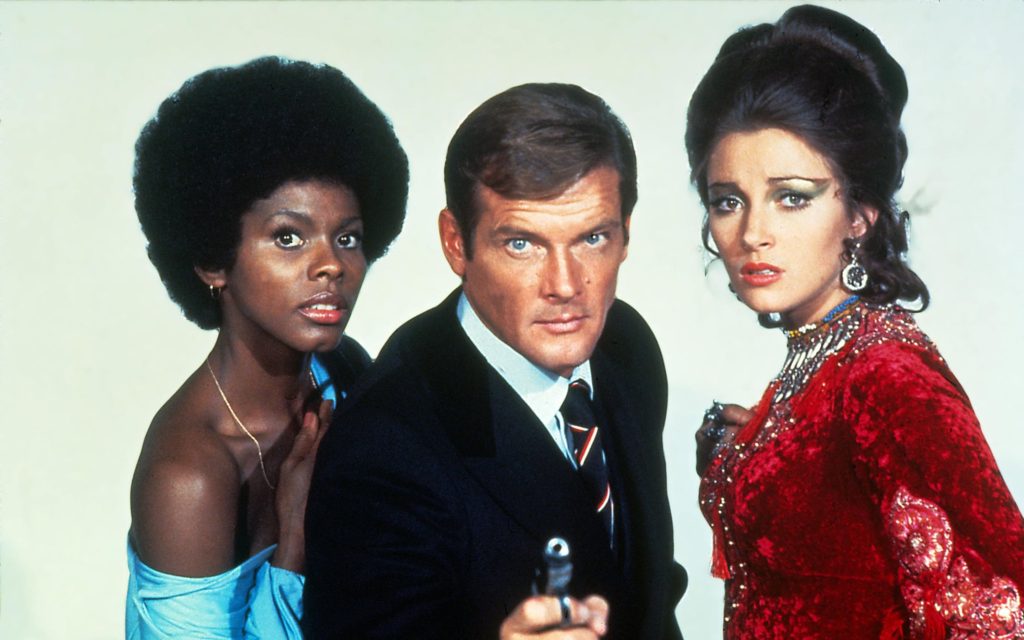
“Just testing an old adage. ‘Unlucky at cards…”
The eighth James Bond film, Live And Let Die, released in 1973, eleven years after Dr. No, brought us a new 007, in the form of Roger Moore. But introducing the new Bond seems to take back seat to setting up the story. Neither the actor nor the character are featured in the pre-credits sequence. The first film to do this.
Moore was fresh off his successful turn as Simon Templar in the series The Saint. He came to the role at the age of forty-five. According to the Fleming incarnation in the novels, this is the age at which one is expected to retire. He brought a different feel to the series. And the producers, Harry Saltzman and Albert ‘Cubby’ Broccoli were intent on fostering that difference. Though they happily brought back director Guy Hamilton to guide Moore’s first excursion.
This is the second film of three, to date, that we’ve seen Bond’s flat. Though there is no sign of May, his housekeeper. And that in itself, is jarring. Gone is the subtle class scene in Dr. No, which was kept mostly in shadows, and lets the viewer populate the collection of rooms. Instead, it’s flatly lit, and seems a little too early 70s. Watching the film today, you can only look at the home and think, “Bond lives here? And with his initials embroidered on his robe?” Gah. But seeing as Peter Lamont and Ken Adam weren’t involved, I guess that’s what we get. Not to speak ill of Syd Cain’s work, the rest of the sets work perfectly. But Bond’s domicile is dated and a relic of the times, something Bond should never be.
That wasn’t the only change behind the scenes, or in front of the camera. Q (Desmond Llewelyn) is nowhere to be seen in the film. Though his department does outfit Bond with a watch that has a magnetic field that could disrupt the path of a bullet. Something, that happily isn’t tested, but instead is used as a super-magnet throughout the film instead.
John Barry is gone from the music department for this film. Instead, Beatles’ producer George Martin delivers us a score that is definitely symbolic of the times, but still works. It features a fantastic title track (and the first rock song for the series) by Paul McCartney and Wings. It was nominated for an Academy Award, a first for the official Bond films. Martin’s score is solid. But it doesn’t have the flair and intricacy that some of Barry’s 007 scores were starting to develop.
Ted Moore returns as the Director of Photography. Maurice Binder creates a title sequence that plays wonderfully with McCartney’s theme song. It reminds us once again, that the face may change. But this is a James Bond movie we’re settling in for.
Tom Mankiewicz once again uses the source material, the second Bond novel, as a launching point (though a lot of it would be eschewed and incorporated into future film’s including the tragedy that befalls Felix Leiter – and makes the final appearance of the character in the series until The Living Daylights-, and a dragging over coral, both of which would show up in later films).
Live and Let Die not only introduces a new Bond, it also somewhat embraces the blaxploitation film making that goes on at the time, as a large portion of the film is set in New York, and then in a fictional country in the Caribbean, as Bond goes after Mr. Big/Kananga (Yaphet Kotto who was less than happy with how the character turned out, and the stereotypes the script seemed intent on fostering), a drug dealer, and ambassador who has big plans for the heroin market in America.
Rounding out the cast includes the lovely Jane Seymour, in one of her earliest roles, and breaking hearts around the world immediately with her stunning beauty, David Hedison as Leiter, Geoffrey Holder and his iconic voice as Baron Samedi (and also the film’s choreographer), Julius Harris as Mr. Big’s henchman Tee Hee, who has claws for hands, Gloria Hendry as Rosie Carver (the sacrificial female character, something which recurs throughout the Moore Bonds), and Clifton James who appears as the rather racist sheriff, J.W. Pepper – whether this is a commentary on American law enforcement in general is up to the viewer.
And because Quarrel was killed in Dr. No, a later book in the series, but the first film, we are introduced to Quarrel Jr. (Roy Stewart) a sadly underwritten role, which misses out on the friendship that Bond developed with the character in the novels.
The film also began to highlight the idea of not only showcasing exotic locales (though New York is shot very gritty, and we don’t get a long look at either New Orleans, or Jamaica both of which could have looked truly fantastic in the film), gorgeous women, a big bad, and a henchman or two, but the idea of set pieces that include a truly remarkable stunt.
Live and Let Die features two. One has Bond (played by stunt man Ross Kananga) running across the backs of a row of crocodiles. Sure they were tied down, but the stunt was done for real. Then of course there was the boat chase, simply described in the script as Scene 156, “The most terrific boat chase you’ve ever seen.” The sequence sees Bond’s boat setting a Guinness World Record (later broken) for the longest jump, 110 feet, over land. Set piece stunts would become a essential ingredient to the series.
And while it’s common place now, hang-gliding was new and exciting, so to see it on the screen at the time, must have given a wonderful exciting feel to the film, which was already entertaining, and had the box office to show it, proving that the Bond actor could be changed, and still be successful.
Although not quite at play yet, Moore had a disdain for guns, and the character throughout Moore’s run with it, uses his pistol, Walther PPK or otherwise, rarely. Instead Moore’s Bond embraces his girls, gadgets (including a couple we didn’t know about, which feels like a cheat – including a saw inside the rim of his watch to be used at the climax), and action beats, and there are some truly enjoyable ones, a bus chase, and the crocodile farm escape which segues into the boat chase perhaps being the most memorable, and probably one of the most iconic of the series.
To promote the film before it’s 27 June, 1973 release in North America, or its Royal Premiere in England of 5 July, 1973 the marketing to introduce a new 007 kicked in, and Roger Moore’s likeness was front and centre in the poster art designed for the UK quad, and the US one sheet, designed by Robert McGinnis which puts Bond against a backdrop of tarot cards, with images and characters from the film to convey the excitement of a new James Bond movie.
The film performed wonderfully for the studios, and launched the longest running reign of one actor in the role of the character. Roger Moore would go on to play 007 in seven consecutive films, making one more than Connery. A record that hasn’t been topped yet.
As the credits roll to a close, while Baron Samedi sits and laughs from the front of Bond and Solitaire’s train, we are reminded that James Bond will return in The Man With The Golden Gun.
Thank you again to DK Canada’s 007 library which proved invaluable in my writing, and heightened my rewatch of the film. Check out this trio or reference books, James Bond: 50 Years of Movie Posters, Bond By Design: The Art of the James Bond Films, and The James Bond Encyclopedia.
- Release Date: 6/27/1973




